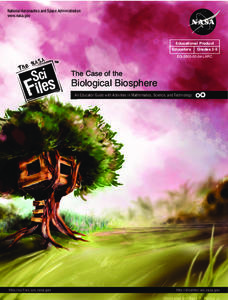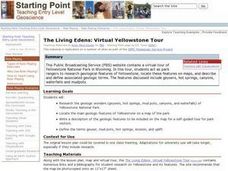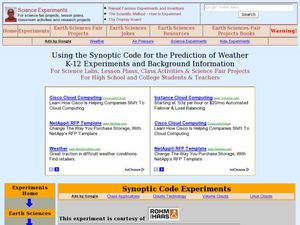Curated OER
Media Arts Production
Students learn about the basic legal and ethical responsibilities shouldered by people making "reality" videos (i.e. videos with non-actors).
Curated OER
The Case of the Biological Biosphere: Health, Math, Technology
Students investigate various aspects of the human body in this imaginative Tree House Detective episode about the biological biosphere. In a series of They take measurements, analyze data, and use technology. The lessons revolve around...
Curated OER
You Be the Judge
Students research and evaluate a case considered by the U.S. Supreme Court regarding the jurisdiction of the Clean Water Act. They watch a Bill Moyers video, conduct a debate, and write about the decision they would make if they were a...
Curated OER
Estuary Interviews
Students role play as newscasters to highlight the lives of estuary animals. For this estuary animal lesson, students watch local new shows to examine how interviews take place. They research the lives of animals that live in estuaries...
Curated OER
Slanted Sentences
Students examine biased words in news articles, suggest synonyms, then rewrite the sentences to demonstrate how word choice can alter meaning.
Curated OER
Stonehenge: Solving Ancient Mysteries
Learners explore archeologists and anthropologists and the tools and methods they use to gather and interpret scientific evidence. They research current archaeological excavations and contact the scientists working at these digs.
Curated OER
Keeping It Quiet
Students consider ways in which countries use censorship to control information. They examine China's recent abridgement of a politician's speech and consider China's recent history with other nations to better explain why censorship is...
Curated OER
Digesting the News
Students explore the editorial concepts, site designs and business models of online news digests. They propose detailed plans for Web sites that demonstrate their own areas of expertise.
Curated OER
Beautiful Bugs
Students investigate the life cycle of ants, ladybugs, and butterflies. They list the four stages of the butterfly life cycle, define symmetry and observe how ants make homes in dirt.
Curated OER
One Good Turn Deserves Another
Students make observations about shapes and 1-, 2-, and 3-dimensional objects. They conduct observations and make predictions regarding transformations of simple geometric shapes. They identify shapes that occur in household items.
Curated OER
Religious Intolerance and the Salem Witch Trials
Students describe the basic beliefs of the Puritan religion; identify the principle figures in the Salem Witch Trials;explain the events that led to the mass hysteria suffered by the town; analyze the First Amendment; and examine...
Curated OER
SMOKING: A RISK WORTH TAKING OR JUST A DRAG?
Students identify and state a tobacco-related decision problem/issue, viable options regarding the selected problem; research and discuss risks and benefits associated with the decision problem; and state a decision based upon rational...
Curated OER
Arts in a Spin Qualities of the Baroque Style
Students examine the qualities of Baroque style by viewing a video about Bach. They listen to music of the era and explore the characteristics of excessive ornamentation, contrast and tension. They complete the included worksheets.
Curated OER
The High and the Flighty
Students study women aviators and act out a talk show-style interview with one of them. They plot Amelia Earhart's flights on a map.
Curated OER
The Living Edens: Virtual Yellowstone Tour
Students take an online virtual tour of Yellowstone National Park. They act as park rangers to research geological features of Yellowstone, locate these features on maps, and describe and define associated geologic terms.
Curated OER
Current Groundwater Contamination Research
Students research the effects of groundwater pollutants on life. They name and describe 1 environmental factor that has an effect on our drinking water. Students read the Water-Groundwater and Pollution Article. They discuss and...
Curated OER
Literature: Watching Anna
Students view the PBS presentation of Leo Tolstoy's, "Anna Karenina." Prior and after each episode, they discuss plot and characterization and in one lesson, use adjectives to describe each of the main characters. Then, students create...
Curated OER
Simulating a Middle East Peace Summit
Tenth graders explore the issues in the Middle East. In this World History lesson, 10th graders research the problems between Palestine and Israel. Students write a speech on their point of view of the peace process.
Curated OER
What's in a Garden?
Students explore the concept of philanthropy. In this service learning lesson, students plan a garden. Students write a paragraph in their journals giving their recommendation on how their garden should be laid out.
Curated OER
Immigration Debate
Students investigate the law recently passed in Arizona, "Support our Law Enforcement and Safe Neighborhoods Act." In this history lesson, students watch a video on immigration then work in small groups to prepare a debate on the pros...
Curated OER
The Battle for Congress: Midterm Elections 2010
Students research midterm elections. In this United States Congress lesson, students use the Internet to explore the issues, candidates, platforms and stakes of the midterm elections of 2010. This extensive lesson makes use of...
Curated OER
Enough About I — Let’s Talk About Me
Students review parts of speech and share informative usage presentations to their classmates. In this grammar lesson, students discuss the importance of using appropriate speech and then read "The I's Have It." Students create their own...
Curated OER
The Loneliest Animals
Students examine the different species that are headed towards extinction. In this animal population lesson students compare the causes of extinction, research an endangered species and present an oral report.
Curated OER
Using the Synoptic Code for the Prediction of Water
Students construct a thermoscreen for the experiment. In this earth science instructional activity, students make observations and interpret them using synoptic codes. They predict the weather based on gathered information.

























